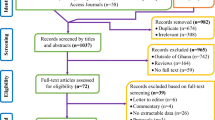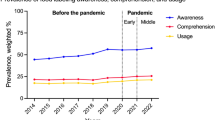Abstract
Background/Objective:
Developing tailored and effective food safety education for young adults is critical given their future roles as caregivers likely to be preparing food for populations who may be at greater risk for foodborne disease (FBD). The objective of this study was to examine the relationship between food safety self-reported food-handling behaviors and cognitions of young adults to observed food-handling behaviors.
Subjects/Methods:
Participants were 153 young adults (mean age 20.74±1.30 s.d.) attending a major American university. Each prepared a meal under observation in a controlled laboratory setting, permitted researchers to observe their home kitchen and completed an online survey assessing food safety knowledge, behavior and psychosocial measures. Descriptive statistics were generated for participants’ self-reported food-handling behaviors, psychosocial characteristics, knowledge, food preparation observations and home kitchen observations. Determinants of compliance with safe food-handling procedures while preparing a meal and home food storage/rotation practices were identified using backward regression models.
Results:
Participants engaged in less than half of the recommended safe food-handling practices evaluated and correctly answered only two-thirds of the food safety knowledge items. They reported positive food safety beliefs and high food safety self-efficacy. Self-reported compliance with cross-contamination prevention, disinfection procedures and knowledge of groups at greatest risk for FBD were the best measures for predicting compliance with established safe food-handling practices.
Conclusion:
Food safety education directed toward young adults should focus on increasing awareness of FBD and knowledge of proper cross-contamination prevention procedures to help promote better compliance with actual safe food handling.
This is a preview of subscription content, access via your institution
Access options
Subscribe to this journal
Receive 12 print issues and online access
$259.00 per year
only $21.58 per issue
Buy this article
- Purchase on Springer Link
- Instant access to full article PDF
Prices may be subject to local taxes which are calculated during checkout
Similar content being viewed by others
References
AbuSabha R, Achterberg C (1997). Review of self-efficacy and locus of control for nutrition- and health-related behavior. J Am Diet Assoc 97, 1122–1132.
Altekruse S, Yang S, Timbo B, Angulo F (1999). A multi-state survey of consumer food-handling and food-consumption practices. Am J Prev Med 16, 216–221.
American Dietetic Association Foundation and ConAgra Foundation (1999). Home Food Safety Benchmark Survey. The American Dietetic Association: Chicago.
Anderson JB, Shuster TA, Hansen KE, Levy AS, Volk A (2004). A Camera's view of consumer food-handling behaviors. J Am Diet Assoc 104, 186–191.
Berk RA (1986). A consumer's guide to setting performance standards on criterion referenced tests. Rev Educ Res 56, 137–172.
Bowman J (1999). Validation of a food safety and grocery shopping survey by observation of usual behaviors. Colorado State University, Ft. Collins (master's thesis).
Bruhn C (1997). Emerging infectious disease (electronic version). Consumer Concerns: Motivating into Action, 3 Available at:ftp.cdc.gov/pub/EID/vol3no4/ascii/bruhn.txt.
Byrd-Bredbenner C, Maurer J, Wheatley V, Cottone E, Clancy M (2007a). Food safety hazards lurk in the kitchens of young adults. J Food Prot 70, 991–996.
Byrd-Bredbenner C, Maurer J, Wheatley V, Cottone E, Clancy M (2007b). Observed food safety behaviors and skills of young adults. Br Food J 107, 519–530.
Byrd-Bredbenner C, Maurer J, Wheatley V, Schaffner D, Bruhn C, Blalock L (2007c). Food safety self-reported behaviors and cognitions of young adults: results of a national study. J Food Prot 70, 1917–1926.
Byrd-Bredbenner C, Wheatley V, Schaffner D, Bruhn C, Blalock L, Maurer J (2007d). Development and implementation of a food safety knowledge instrument. J Food Sci Educ 6, 46–55.
Byrd-Bredbenner C, Wheatley V, Schaffner D, Bruhn C, Blalock L, Maurer J (2007e). Development of food safety psychosocial questionnaires for young adults. J Food Sci Educ 6, 30–37.
California Food Emergency Response Team (2007). Investigation of an Escherichia coli o157:H7 outbreak associated with Dole pre-packaged spinach. Available at: http://www.dhs.ca.gov/ps/fdb/local/PDF/2006%20Spinach%20Report%20Final%20redacted.PDFRetrieved March 28, 2007.
Contento I, Balch G, Bronner Y, Paige D, Gross S, Bisignani L et al. (1995). Special issue, the effectiveness of nutrition education and implications for nutrition education policy, programs, and research: a review of research, chapter V. Nutrition education for adults. J Nutr Educ 27, 312–328.
Coscarelli W, Shrock S (2002). The two most useful approaches to estimating criterion-referenced test reliability in a single test administration. PIQ 15, 74–85.
Dennis KE, Goldberg AP (1996). Weight control self-efficacy types and transitions affect weight-loss outcomes in obese women. Addict Behav 21, 103–117.
Department of Labor (2000). Trends in youth employment: data from the current population study. Available at: http://www.bls.gov/opub/rylf/pdf/rylf2000.pdf. Retrieved April 24, 2007.
Endres J, Welch T, Perseli T (2001). Use of a computerized kiosk in an assessment of food safety knowledge of high school students and science teachers. J Nutr Educ 33, 37–42.
Fein S, Lin CT, Levy A (1995). Foodborne illness: perceptions, experience, and preventive behaviors in the United States. J Food Protec 58, 1405–1411.
Food and Drug Administration, US Department of Agriculture, US Environmental Protection Agency, and Centers for Disease Control and Prevention (1997). Food safety from farm to table: a new strategy for the 21st century. Available at: http://vm.cfsan.fda.gov/~dms/fs-draft.html. Retrieved August 24, 2003.
Food Safety and Inspection Service and US Department of Agriculture (1998a). CDC Reports: behavioral risk. The Food Safety Educator. Available at: http://www.fsis.usda.gov/News_&_Events/food_safety_educator/index.asp. Retrieved November 28, 2001.
Food Safety and Inspection Service and US Department of Agriculture (1998b). FDA: consumers are changing. The Food Safety Educator 3, 4.
Food Safety and Inspection Service and US Department of Agriculture (1998c). New consumer research driving food safety education. The Food Safety Educator 3, 4.
Haapala I, Probart C (2004). Food safety knowledge, perceptions, and behaviors among middle school students. J Nutr Educ Behav 36, 71–76.
Helms M, Vastrup P, Gerner-Smidt P, Molbak K (2003). Short and log term mortality associated with foodborne bacterial gastrointestinal infections: registry based study. BMJ 326, 357–362.
Huffman M (2007). FDA says peanut butter salmonella outbreak is ‘ongoing’. ConsumerAffairs.Com Available at:http://www.consumeraffairs.com/news04/2007/02/peanut_butter_recall08.html. Retrieved March 28, 2007.
Jay L, Comar D, Govenlock L (1999). A video study of Australian domestic food-handling practices. J Food Prot 62, 1285–1296.
Klontz K, Timbo B, Fein S, Levy A (1995). Prevalence of selected food consumption and preparation behaviors associated with increased risks of food-borne disease. J Food Prot 58, 927–930.
Livingston SA (1972). Criterion-referenced applications of classical test theory. J Educ Meas 9, 13–26.
Lynch M, Painter J, Woodruff R, Braden C (2006). Surveillance for foodborne-disease outbreaks—United States, 1998–2002. Morb Mortal Wkly Rev 55 (SS10), 1–34.
McArthur L, Holbert D, Forsythe W (2007). College students and awareness of food safety. JFSC 99, 60–68.
McMahon K (1996). Will pending health claims regulations motivate consumers to change behaviors. J Nutr Educ 28, 254–257.
Medeiros L, Hillers V, Kendall P, Mason A (2001). Evaluation of food safety education for consumers. J Nutr Educ Behav 33 (Suppl 1), SS27–SS34.
Morrone M, Rathbun A (2003). Health education and food safety behavior in the university setting. J Environ Health 65, 9–15,28.
Nayga R (1996). Sociodemographic influences on consumer concern for food safety: the case of irradiation, antibiotics, hormones, and pesticides. Rev Agri Econ 18, 467–475.
Partnership for Food Safety Education (1998). Fight Bac! Snapshot of consumer behavior and attitudes. Available at: www.fightbac.org/media/snapshots.htm. Retrieved December 29, 1999.
Patil SR, Cates S, Morales R (2005). Consumer food safety knowledge, practices, and demographic differences: findings from a meta-analysis. J Food Prot 68, 1884–1894.
Prochaska J, Redding C, Evers K (2002). The transtheoretical model and stages of change. In: Glanz K, Rimer B and Lewis F (eds) Health Behavior and Health Education: Theory, Research, and Practice pp 99–120. San Francisco: Jossey-Bass.
Ratzan SC, Payne JG, Massett HA (1994). Effective health message design: the America responds to AIDS campaign. Am Behav Sci 38, 294–309.
Rodgers WM, Brawley LR (1996). The influence of outcome expectancy and self-efficacy on the behavioral intentions of novice exercisers. J Appl Soc Psychol 26, 618–625.
Unklesbay N, Sneed J, Toma R (1998). College students’ attitudes, practices, and knowledge of food safety. J Food Prot 61, 1175–1180.
Viscusi WK, Magat WA, Huber J (1986). Informational regulation of consumer health risks: an empirical evaluation of hazard warnings. Rand J Econ 17, 351–365.
Williamson D, Gravani R, Lawless H (1992). Correlating food safety knowledge with home food-preparation practices. Food Technol 46, 94–100.
Yang S, Leff M, McTague D, Horvath K, Jackson-Thompson J, Murayi T et al. (1998a). Multistate surveillance for food-handling, preparation, and consumption behaviors associated with foodborne diseases: 1995 and 1996 BRFSS food-safety questions. Morb Mortal Wkly Rev 47 (SS-4), 33–57.
Yang S, Leff M, McTague D, Horvath K, Jackson-Thompson J, Murayi T et al. (1998b). Multistate surveillance for food-handling, preparation, and consumption behaviors associated with foodborne diseases: 1995 and 1996 BRFSS food-safety questions. Appendix. Morb Mortal Wkly Rev 47 (SS-4), 55–57.
Acknowledgements
This research was funded by the US Department of Agriculture, National Food Safety Initiative, grant No. 2003-51110-01736.
We thank Ellen Cussler, MS, University of Arizona, Department of Physiology, for her invaluable assistance with data analysis and interpretation.
Author information
Authors and Affiliations
Corresponding author
Additional information
Contributors: JMA was responsible for research coordination, data collection and writing of the manuscript. CB-B was responsible for research development, statistical analysis and writing of the manuscript. DS, CMB and LB provided significant advice regarding research development, manuscript structure and revision of the manuscript.
Rights and permissions
About this article
Cite this article
Abbot, J., Byrd-Bredbenner, C., Schaffner, D. et al. Comparison of food safety cognitions and self-reported food-handling behaviors with observed food safety behaviors of young adults. Eur J Clin Nutr 63, 572–579 (2009). https://doi.org/10.1038/sj.ejcn.1602961
Received:
Revised:
Accepted:
Published:
Issue Date:
DOI: https://doi.org/10.1038/sj.ejcn.1602961
Keywords
This article is cited by
-
Modeling farmers’ responsible environmental attitude and behaviour: a case from Iran
Environmental Science and Pollution Research (2019)
-
Food safety knowledge of undergraduate students at a Canadian university: results of an online survey
BMC Public Health (2016)
-
A systematic review and meta-analysis of the effectiveness of food safety education interventions for consumers in developed countries
BMC Public Health (2015)



